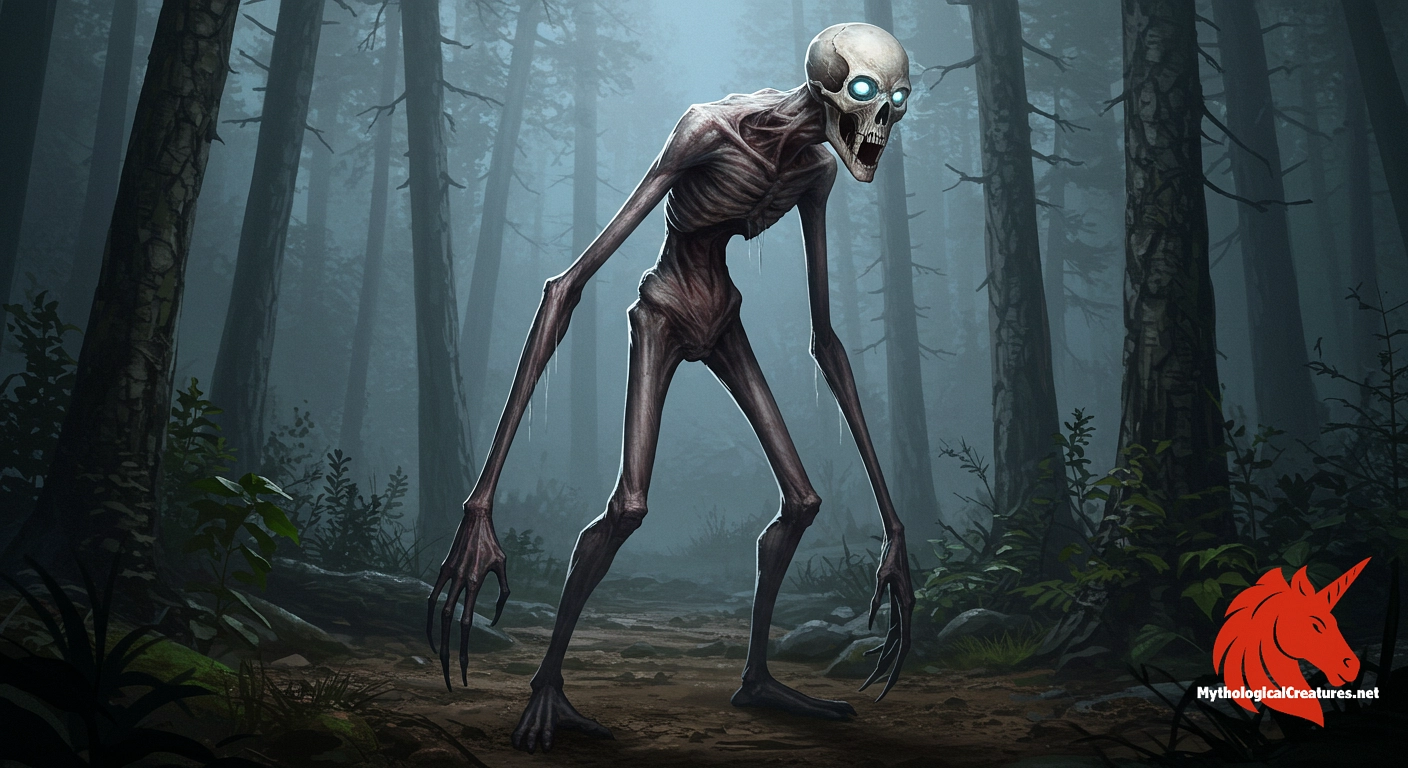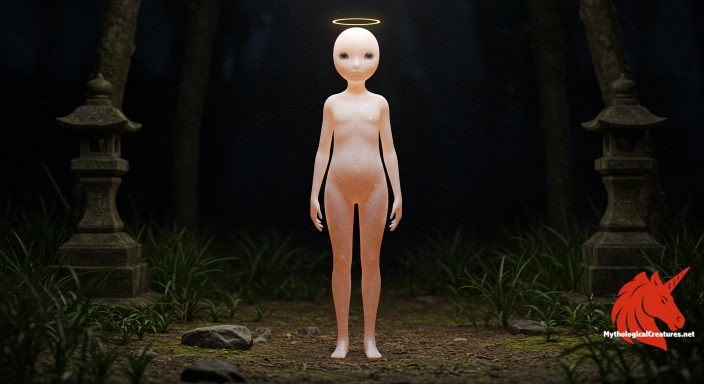Baykok: The Baykok is a malevolent spirit from Ojibway mythology, renowned for its ghostly and skeletal appearance.

Baykok
Baykok - Serves as a cautionary figure in Ojibway folklore, representing the dangers of the wilderness and the presence of malevolent supernatural forces.
Origins & First Encounters
The Baykok is a notorious and foreboding figure in the mythology of the Ojibwe nation, embodying a malevolent spirit that haunts the woodlands. Born from ancient oral traditions, this spectral entity has mesmerised storytellers and instilled fear in those who traverse the deep, silent forests. Its earliest mentions appear in the intimate recitations of elders whose narratives were passed down over countless generations. The Baykok’s characteristics intertwine with natural cycles, reflecting the delicate balance between life and death in indigenous worldviews. Early ethnographic accounts, though sparse, attest to an unsettling presence that both punished and warned against transgression. Revered and reviled in equal measure, the spirit is as much a symbol of nature’s retribution as it is of its mysterious benevolence. The myth has sustained its power by evolving with cultural shifts, adapting its lessons to reflect the realities of its native audience. Narratives of the Baykok persist in communal gatherings, where each retelling reinforces its warning against the disruption of natural order. Its enduring allure lies in an ability to frighten, provoke contemplation, and remind listeners of the inexorable laws that govern the world.
Source Texts & Tale Variants
Ancient oral traditions serve as the primary source for the myriad legends surrounding the Baykok, each recitation adding layers to its complex persona. Tales of this malevolent spirit have been captured in the memories of Ojibwe storytellers and later documented by early observers of indigenous culture. Verbal accounts and fragmented records reveal a creature both elusive and terrifying, whose reputation grew with each retelling. Variants of the myth describe encounters that occur under shadowy skies, where the spirit emerges without warning. Some narratives recount solitary meetings on frosty nights, while others speak of communal experiences that left lasting imprints on local lore. The diverse story variants underscore a shared understanding that the Baykok is both an omen of doom and an agent of nature’s justice. Despite inconsistencies in detail, most sources concur on the spirit’s foreboding presence and its spectral appearance. Secondary folklore, enriched over time as stories intermingled with neighbouring traditions, has preserved a vibrant mosaic of accounts. This multiplicity in storytelling highlights the dynamic and evolving nature of indigenous myth, where each version contributes to a broader cultural narrative.
Form & Powers
Descriptions of the Baykok evoke powerful imagery, portraying it as a gaunt and spectral figure whose very appearance seems to summon dread. Often depicted as a skeletal presence, the entity is said to possess elongated, twisted limbs and eyes that glow with an otherworldly intensity. Many accounts describe its skin as bearing the ashen texture of burnt remains, enhancing the impression of decay that surrounds it. The creature’s face is frequently rendered as a grotesque mask, with hollow sockets and a sunken visage hinting at a long-lost humanity. In some traditions, tattered remnants of clothing or the suggestion of battle adornments add to the suggestion that the Baykok might once have been human. Variations in the myth offer differing portrayals, with some emphasising a towering, ominous stature and others depicting a slight, almost insubstantial form that can vanish into the mist. Its physical manifestation is not only a source of terror but also a symbol of mortality and the inevitable decay pervasive in the natural world. The intricate blend of human and monstrous features in its depiction reinforces its role as an embodiment of nature’s darker, retributive aspects. Every descriptive detail contributes to a chilling portrait that has captivated the imagination of those who dare to recount its legend.
Regional Faces
The legend of the Baykok has traversed various indigenous communities, adapting its name and attributes to local cultural landscapes. Known by different appellations such as pau'guk, paguk, and baguck, the spirit’s mutable identity reflects the linguistic diversity of Algonquian-speaking peoples. In some regions, the Baykok is portrayed not solely as a bringer of dread but also as an arbiter of natural balance, ensuring that no mortal transgresses against the sacred order. Local narratives often intertwine its presence with the rhythms of the seasons, particularly highlighting its activities during the harsh winter months. Adaptations of its story mirror the unique environmental conditions of each area, connecting the spirit directly to local forests, lakes, and rugged terrain. Certain communities cast it as a solitary guardian of the wild, while others present it as an omnipresent force that haunts the boundaries between the human world and the supernatural. Such regional variations illustrate how oral traditions mould myth to reflect community values and environmental realities. The Baykok’s fluid portrayal underscores the adaptability of indigenous mythology, where a single entity can simultaneously embody multiple layers of meaning. This regional diversity enriches the legend, ensuring that the spirit remains a potent symbol across different cultural settings.
Cultural Parallels
In the broader context of global mythologies, the Baykok shares intriguing parallels with other spectral figures whose appearances forewarn inevitable doom. Its eerie, skeletal form is reminiscent of the European Grim Reaper, both entities serving as somber ministers of death. Unlike some Western personifications of mortality, the Baykok is deeply rooted in nature and the intrinsic connection between the land and the human spirit. Similarities can also be drawn with the Celtic banshee, whose mournful presence is traditionally linked to impending loss. Such cross-cultural comparisons reveal that many societies have fashioned figures that embody the universal themes of mortality and retribution. Despite originating from the specific cultural milieu of the Ojibwe, the Baykok echoes the human fascination with life’s transient nature found in diverse traditions. Its narrative functions as a moral compass, cautioning against the disruption of natural or social order, a theme common to indigenous and shamanistic stories worldwide. Comparative analysis highlights that while details differ, the symbolic resonance of death and nature’s vengeance remains consistent. This interconnection among mythologies not only enriches the Baykok’s legend but also reveals the shared human experience of confronting the unknown.
Legacy & Modern Evolution
The evolution of the Baykok myth demonstrates a remarkable journey from ancient oral tradition to a modern cultural icon. Over the centuries, its fearsome image has been reinterpreted to speak to contemporary themes such as environmental degradation and the repercussions of human hubris. While originally confined to the intimate circles of indigenous storytelling, the spirit has seeped into modern art, literature, and cinema, reinvented by a new generation of creators. Artists and writers now often cast the Baykok as both a literal and allegorical figure, embodying nature’s silent protest against the exploitation of its resources. This modern reinterpretation retains the traditional ominous presence of the spirit while adding layers that critique modern societal and ecological challenges. The iconography of the Baykok, with its stark symbolism of decay and retribution, continues to resonate with an audience attuned to issues of environmental stewardship. As indigenous communities reclaim their narratives, the myth of the Baykok is celebrated as a vital link between ancestral wisdom and contemporary reflection. Its presence in modern media reaffirms that ancient myths can evolve, maintaining their core message while addressing new realities. Ultimately, the enduring legacy of the Baykok underscores the power of myth to bridge the past with the present and to provoke thoughtful engagement with the mysteries of existence.
Interesting Fact
The Baykok’s array of names across Ojibwe and Algonquin languages reflects a deep, shared cultural narrative, emphasizing how indigenous peoples personify natural and supernatural dangers in diverse yet interconnected ways.
Quick Creature Info
Origin:
Our Mythic Legendary Rating:

Also Sometimes Known As:
Habitat:
Supernatural Powers:
Physical Attributes:
Abilities:
Behavior:
Weaknesses:
Lore:
Related Creatures, Tales or Lore
- WWendigo
- PPukwudgie
- SSkin-walker
References
Discover Another Mythical Legend You May Not Have Heard Of?
Uncover the mysteries of ancient folklore and expand your knowledge of legendary beings from cultures around the world.
Dare to Meet the Mitama....
Mythical Disclaimer: The images and data on this site are derived from various historical and literary sources, but we have found that many myths often have multiple versions and interpretations across references, sometimes contradictory. As a result, these creature depictions are artistic interpretations—imaginative blends of folklore, legend, and a dash of AI guesswork. Because creature descriptions vary widely, our illustrations and accompanying information represent our best effort to honor mythology while bridging creative gaps. Enjoy these interpretations—just remember, we've done our best to respect the stories and validate available data, but in the realm of mythology, details often shift, imagination leads the way, and nothing is ever set in stone!
Curated by the Mythological Creatures Team (rev. May 2025)
